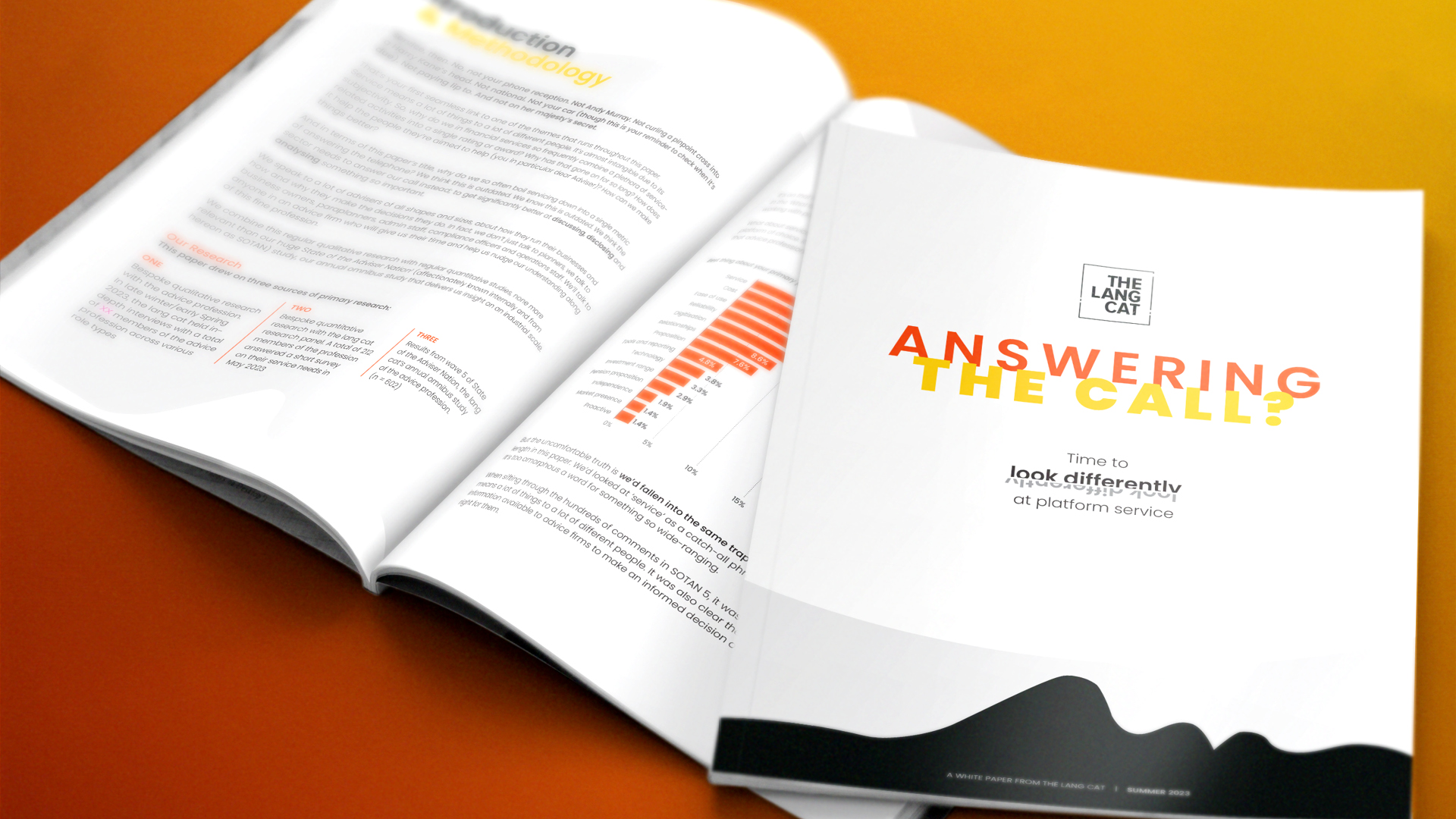<<EDIT – Since writing this SL has been in touch – hi, how you doing – to say that I got the charging structure wrong – the charge on the total pot changes at various trigger points rather than a set charge applying to each tranche. Very happy to amend – this stuff has to be right and I hate that I got the wrong end of the stick. What it does is sharpen up SL’s pricing across the board and in fact they lead the pack at a few points – however there is an anomaly in how I do the tables in that their pricing steps at £99,999 and I do the table at £100k, so they get the benefit of a 5bps cliff-edge drop there and at a couple of other points. Whether the pricing is sharp enough to disturb FFN and Cofunds is another matter – but when we factor in rebate levels (I can’t talk about specifics) there could be an interesting pricefight on. A fascinating prospect, especially against Skandia. The one thing I will say is that just using the word ‘stepped’ in a brochure doesn’t do the whole job – the description of how the charging works led your correspondent, who ain’t unfamiliar with how to design charging structures, to believe it was a tranched/tiered structure. One for next reprint, perhaps. I’ve put the new numbers in the table in italics and updated the text (mainly in SL’s favour). Apologies to SL and thanks for pointing out the error. Cheers, Mark.>>
So it feels a little weird writing this. It’s hard to write objectively about things with which you were closely involved. I’ll just write subjectively then…
I try to update this every time someone announces fresh pricing. Latest to the transparency diary room is my old mucker Standard Life, who today announces plans to unbundle its retail SIPP and FundZone fund supermarket. SIPP outsells FundZone by something like a billion to one, but at the same time (stay awake at the back), FZ is the in-house investment platform for SIPP. Claro?
Wait, there’s more. Neither of these have anything to do with Standard Life Wrap or Wrap SIPP really in terms of pricing, although the SIPP on Wrap is pretty much the same bar a few tweaks as the retail version and all of Wrap uses the underlying FNZ transaction hoojamawhatsit which also powers FundZone. What I always liked about SL’s proposition was how simple and intuitive it was. *coughs*
Anyway, just for this blog I’m going to concentrate on FundZone as the standalone fund supermarket; I might do some SIPP stuff later. FZ was bundled, just like the other supermarkets, and it’s always been a source of frustration on Lothian Road that it didn’t take its place alongside FNW, Cofunds and Skandia. This was largely down to it being launched before it was fully built and being really a half-formed proposition in search of a market. No-one woke up thinking “Hmmm, what we need is another bundled supermarket! Quick, call Standard Life and see if they can bosh one out!”
So I suspect the hope in SL Towers is that RDR will be a fresh start for FundZone. Crucial to that fresh start will be how it’s priced – folk will need a reason to disturb their existing relationships. So let’s dive into a quick & durrrrty analysis:
The new charging structure (clipped from their brochure, all rights reserved etc) is on the right. The first thing to notice is that it’s stepped even at lower portfolio sizes, which, while not as irritating as tiered structures, remains a pain. It also introduces the weird situation where someone near a step point can see their charge yo-yoing as market movements take them over the step point and back again. Providers who can’t put simplicity first and feel the need to protect themselves at various portfolio levels always betray the same thing – a lack of control of fixed costs.
To be fair, it’s not as bad as some of them, but still. So SL has set its cap just a little higher than Fiddy and Cofunds in terms of basis points, but without the annual platform charge on top. None of these propositions have trading charges any more for mutual funds (at least not post-RDR) and they all give full rebates back to the client. So here’s how it looks in a bijou table-ette:
|
Portfolio size |
£20k |
£50k |
£75k |
£100k |
£200k |
£500k |
£1m |
|
Cofunds |
0.49% |
0.37% |
0.35% |
0.33% |
0.30% |
0.26% |
0.22% |
|
Aviva |
0.25% |
0.25% |
0.25% |
0.25% |
0.25% |
0.25% |
0.25% |
|
FFN |
0.48% |
0.34% |
0.31% |
0.29% |
0.27% |
0.26% |
0.25% |
|
SL FundZone |
0.35% |
0.30% |
0.30% |
0.25% |
0.25% |
0.20% |
0.20% |
I’d have included Skandia, but no-one has a clue what it’s doing because until it knows how badly it’s damaged as a result of the regulator’s stance on rebates it won’t tell anyone what the price will be. Ho hum. I have included Aviva – it doesn’t have a fund supermarket but is being very aggressive for ISA business at low pot sizes and so worth mentioning here.
The bold figures are the lowest. Aside from Aviva, Standard is a clear leader by dint of not having fixed fees at the lower end and the stepped structure further up, but fixed fees only bite for small pots and everyone is within a few basis points by £75k. Given that most supermarket business is below that level, that’s probably fine. SL also stretches away at the step points, especially £100k and £500k (but see below). So for price-sensitive business, there is a reason to consider SL, across the portfolio spectrum. However, where SL looks sharp at, say, £100,000 (25bps to Cofunds’ 33 and FFN’s 29), it looks a lot less sharp at £99,999 where you’re the wrong side of the cliff edge and paying 30bps instead. Advisers need to keep their eyes open here.
So from this, FZ looks like a good alternative to the Big 3 and certainly excellent for the more modest customer. Beyond that it either looks in good shape or is there or thereabouts, but unless you have another reason to move from Fiddy or Cofunds you might not do it on price alone – and replacement business as we all know from GC12/06 is keenly sensitive to price. Taken in the round, this structure is probably good enough to give those considering a move air cover to do so. However, it also means IFAs have to do in-depth comparisons and I am left with a nagging wish that SL had just put in a flat structure, like FFN, and made it easy for everyone. I think I would find it hard to explain to a client why they are at the mercy of arbitrary cliff-edge points and why reconciling the charges they pay is so complex. For balance, though, I also should point out that unless the step points are dynamised for inflation, they will gradually erode over time, assuming portfolios keep pace with inflation or better (ha ha). So they get less valuable to SL over time. Which again begs the question of why bother having them at all…
SL’s soft underbelly is the mess it’s got itself into with publishing rebates. Hilariously, the FZ sales aid says “for maximum transparency, we’ll start publishing…later this year”. God knows I’m not averse to a spot of spin, but ‘maximum transparency’ is a bit rich even for me. Gotta love the chutzpah though.
This underbelly extends into SL’s refusal to publish Wrap pricing and rebates. I’ve been quietly impressed with SL’s charm offensive around RDR – they’ve got IFAs involved in doing it, it’s well written and pretty functional and clear. You don’t have to get clients to sign mandates for adviser charging, unlike Skandia, and there are no centrally imposed limits, keeping SL firmly out the way of the relationship between adviser and client – so important for a company that is viewed with suspicion by so many IFAs. But the Wrap stuff is just a big mis-step.
SL has dodged the bullet so far about total clarity, mainly because everyone is having a laugh sticking the boot into Skandia, but it’s starting to look a bit daft on this front. And that’s frustrating, because in Wrap’s bizarre and intensely annoying semi-bundled structure (and if you think it’s a pain you should try writing a charging brochure for it, it took years off my life back in 2009) clients do, in effect, get the full rebates. SL whips its charge off the rebate and hands over any excess or revisits the client if the rebate doesn’t fund the charges fully. It is, in effect, an unbundled structure masquerading as a bundled one and, for as long as it exists, it will keep getting flak because it’s terribly hard to see what’s going on. A missed opportunity to silence the critics, then.
Right, that’s something like 1000 words which is twice as long as a blog should be, so I’ll bugger off now. Hope this was useful – here’s the ad – we’ve got plenty of price stuff stashed out the back so if you want more detail just give us a shout using the contact form or DM via Twitter (@theactualpolson) and we’ll price (ho, ho) it up for you. Mahalo.




